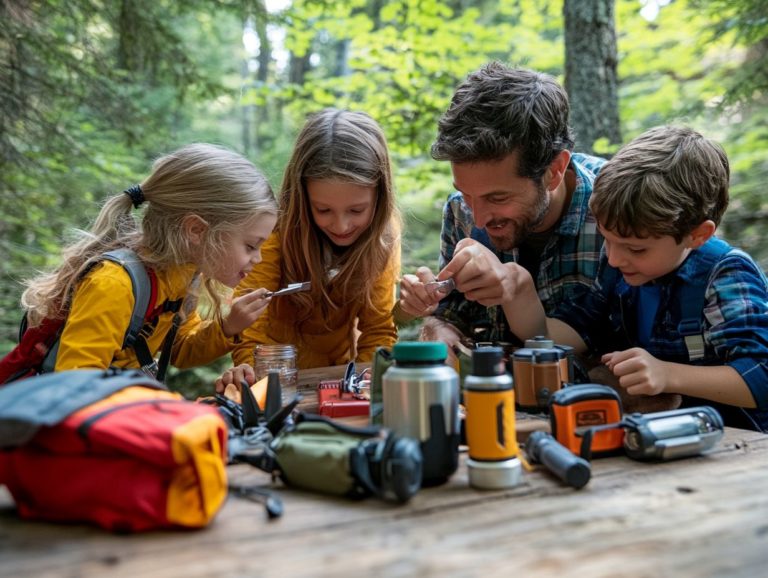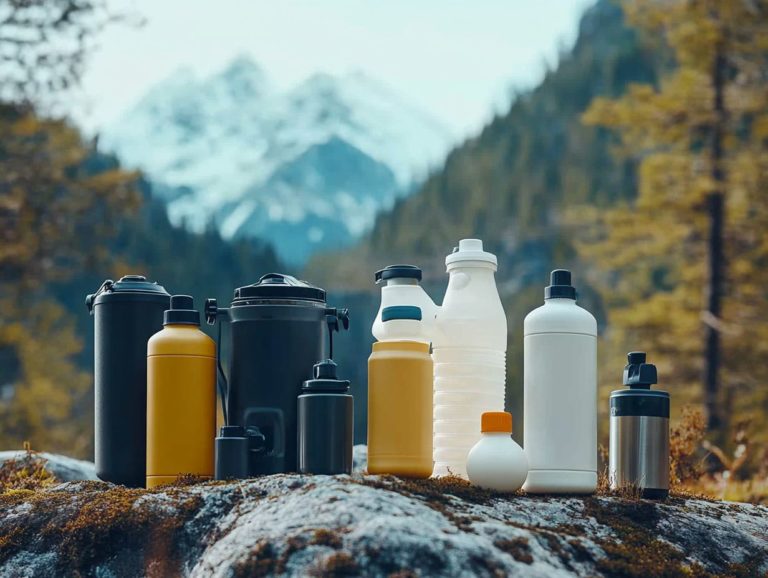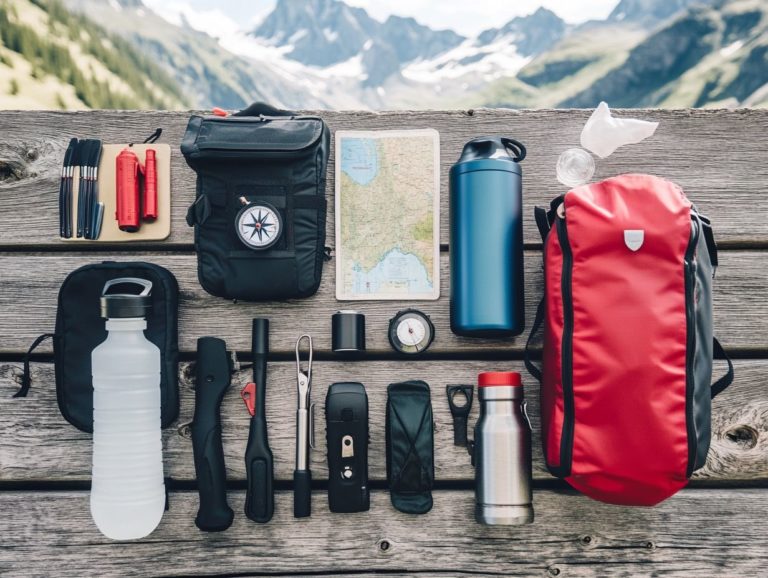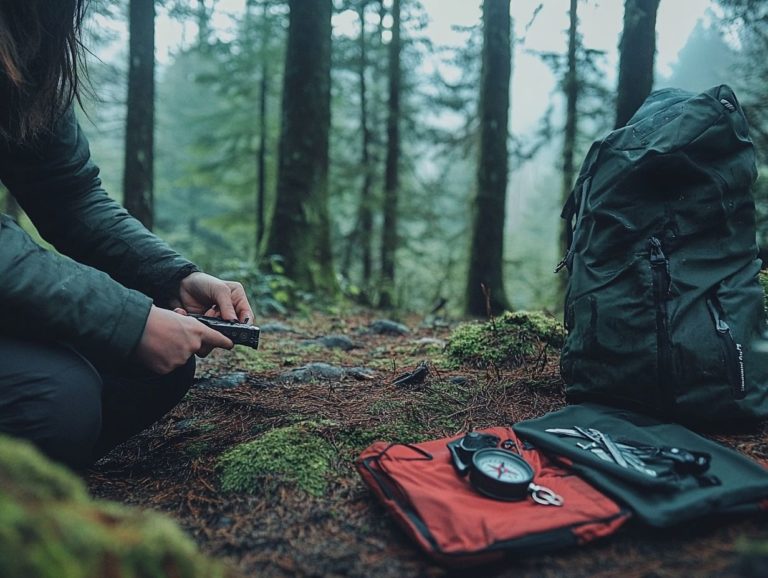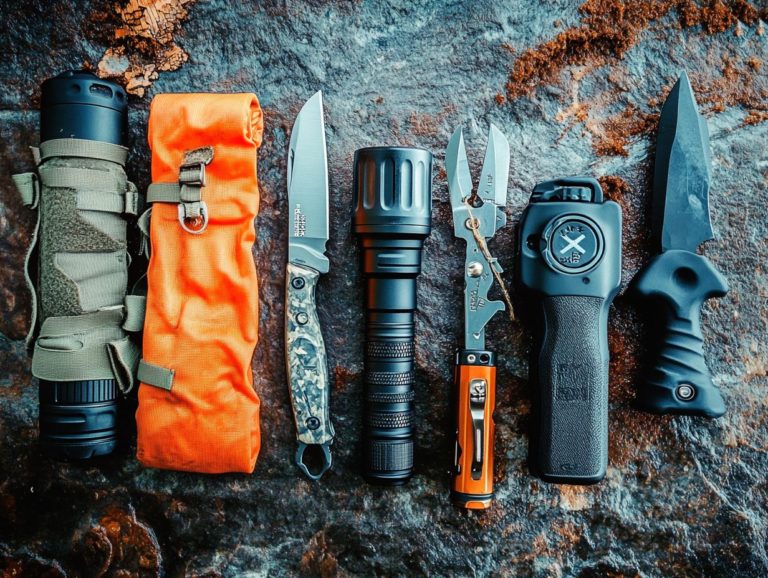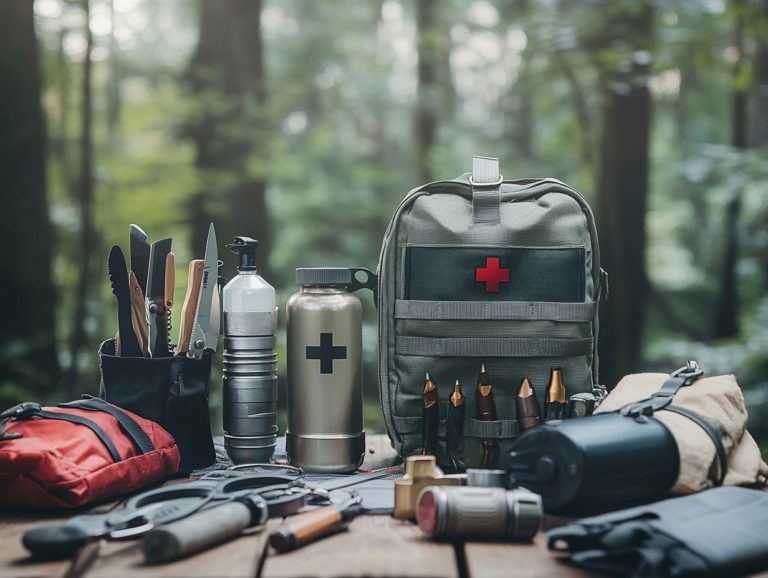What to Include in Your Survival Gear Kit
In an unpredictable world, your preparation can truly make all the difference. A well-equipped survival gear kit is essential for anyone venturing into the great outdoors or seeking peace of mind in emergency situations.
This guide will walk you through the key components of a complete survival kit, including shelter, food, water, first aid, and tools.
You ll discover how to tailor your kit to suit your specific environment and personal needs. Gain insights on building and maintaining a high-quality survival kit that can withstand the test of time.
Equip yourself today to stay safe and thrive, regardless of the challenges that may come your way.
Contents
- Key Takeaways:
- Essential Items for Your Survival Gear Kit
- Additional Considerations for Your Survival Gear Kit
- Building and Maintaining Your Survival Gear Kit
- Frequently Asked Questions
- What to Include in Your Survival Gear Kit?
- Why is it Important to Have a Survival Gear Kit?
- What are the Essential Items to Include in a Survival Gear Kit?
- How Much Water and Food Should be Included in a Survival Gear Kit?
- Do I Need to Customize My Survival Gear Kit?
- How Often Should I Check and Update My Survival Gear Kit?
Key Takeaways:
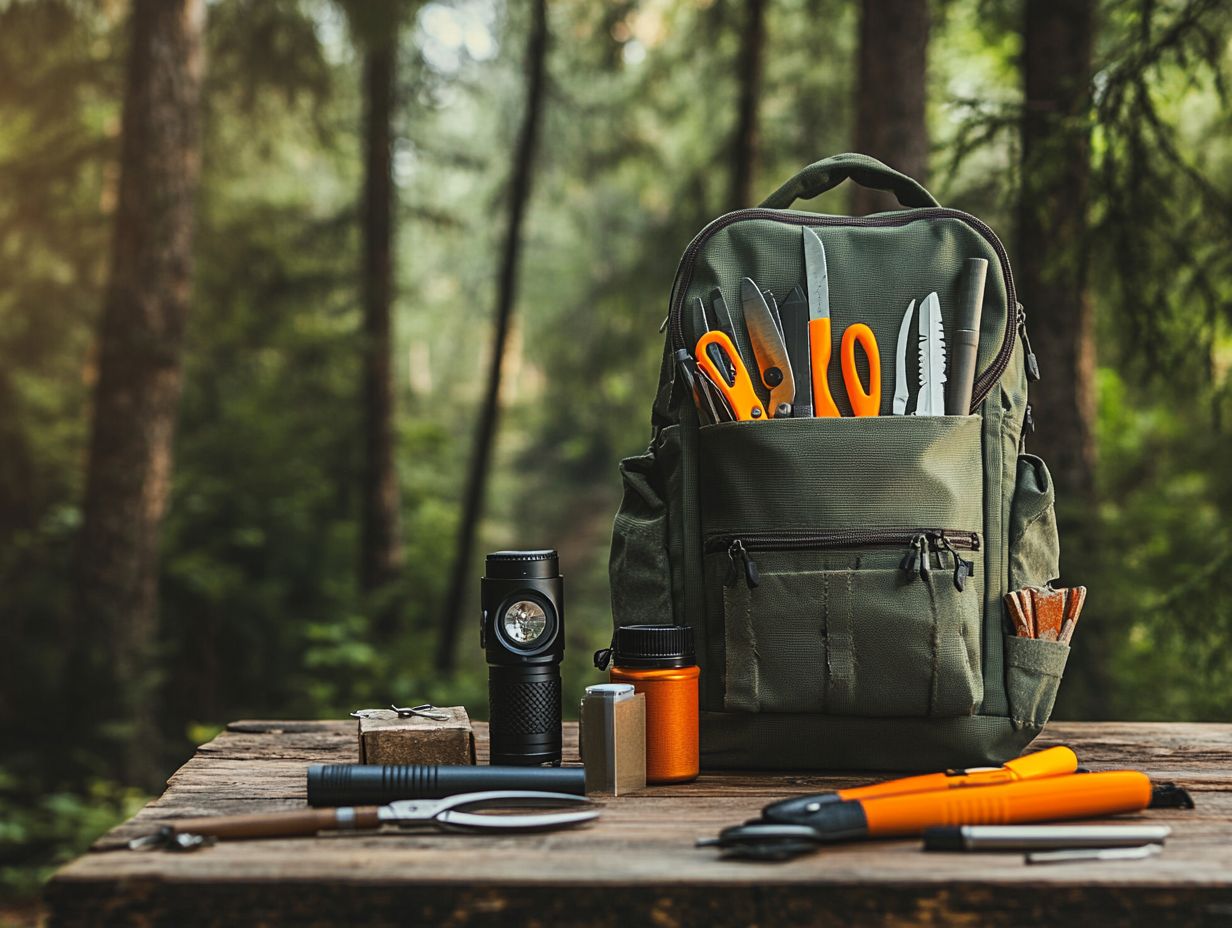
- Make sure to have shelter, water, food, first aid, navigation, and tools in your kit.
- Act now to consider your climate and personal needs when building your kit.
- Regular maintenance is essential to ensure your kit is effective in emergency situations.
What is a Survival Gear Kit?
A survival gear kit is your complete collection of essential items designed to sustain you during unexpected emergencies or survival situations, particularly when facing natural disasters.
These kits typically include supplies such as first-aid items, water storage, food provisions, and communication tools, all geared toward ensuring your safety and preparedness.
Organizations like Global Rescue and the Red Cross stress the importance of having a well-stocked survival kit, as it could make the difference between safety and peril in critical moments. Properly assembling your survival kit is fundamental to effective emergency preparedness, as emphasized by guidance from the CDC.
A well-rounded survival gear kit encompasses several categories, including emergency supplies like flashlights, lighting supplies, batteries, and multi-tools, which are invaluable in a crisis. Don’t forget to include a first-aid kit packed with essential items for immediate treatment of injuries while you await professional help.
Food storage options, particularly long-lasting items, are essential for maintaining your energy levels, while water purification tablets make unsafe water drinkable.
Stacey Dee Woods highlights that customization is key; tailor your kit based on your health needs and the environmental hazards in your area. Katherine Gillespie adds that connecting with resources from the CDC or the Red Cross can provide invaluable insights, enhancing your preparedness and confidence in navigating emergencies.
Essential Items for Your Survival Gear Kit
Building a robust survival gear kit requires an understanding of essential items that can become invaluable in emergencies, particularly during natural disasters.
Here are key items to include in your survival gear kit:
- Water storage systems
- Long-lasting food supplies
- First-aid kits
- Emergency shelter options
All of these serve to establish a safety net for you and your loved ones. Don’t overlook navigation tools and communication devices, such as emergency radios; these are vital for managing your resources and staying informed in critical situations.
Proper organization of these essentials, paired with a carefully curated checklist, is crucial for ensuring you’re prepared when it counts. For more resources or help regarding survival kits, don t hesitate to reach out.
Remember, safety is paramount. Start building your survival kit today!
Shelter and Warmth
In survival situations, having adequate shelter and warmth can dramatically influence your chances of making it through, especially in extreme weather conditions. Essential clothing and footwear, along with emergency shelter options like tents or thermal blankets, are critical parts of your survival gear kit.
Fire-starting supplies are crucial. They provide warmth and allow you to cook food or signal for help. The right choices in this area can keep you safe and comfortable, even in the harshest environments.
When exploring emergency shelter options, lightweight tents stand out as an excellent choice. They are easy to pack and set up quickly, protecting you from rain and wind. On the other hand, thermal blankets offer great insulation and are essential when space is limited, making them a must-have in your emergency backpack.
For clothing, choose layers that draw sweat away from your skin for improved comfort. Insulated footwear is vital for keeping warm in cold climates. Fire-starting supplies, such as waterproof matches or fire starters, enhance your ability to generate heat. Learning to build a shelter near a fire adds an extra layer of safety.
Prepare now! Your survival depends on it!
Water and Food
Water and food are key to survival. They keep you healthy and energized during emergencies. By implementing effective water storage solutions with a reliable water filtration system, you can ensure that safe drinking water is always available. Don’t forget to include water purification tablets for added safety.
Stockpiling non-perishable food supplies and emergency rations allows you and your family to endure prolonged survival situations. Mastering resource management is vital for your emergency preparedness.
Consider various water storage options, from large drums to smaller, portable containers, tailored to meet your hydration needs. It’s wise to explore gravity-fed filtration systems or portable water filters that eliminate contaminants, ensuring clean and safe water.
When it comes to food, include non-perishable items such as canned goods, freeze-dried meals, and nutritious energy bars to create a well-rounded emergency pantry. Regularly check expiration dates and rotate food items to prevent spoilage, keeping your supplies fresh for any situation.
First Aid
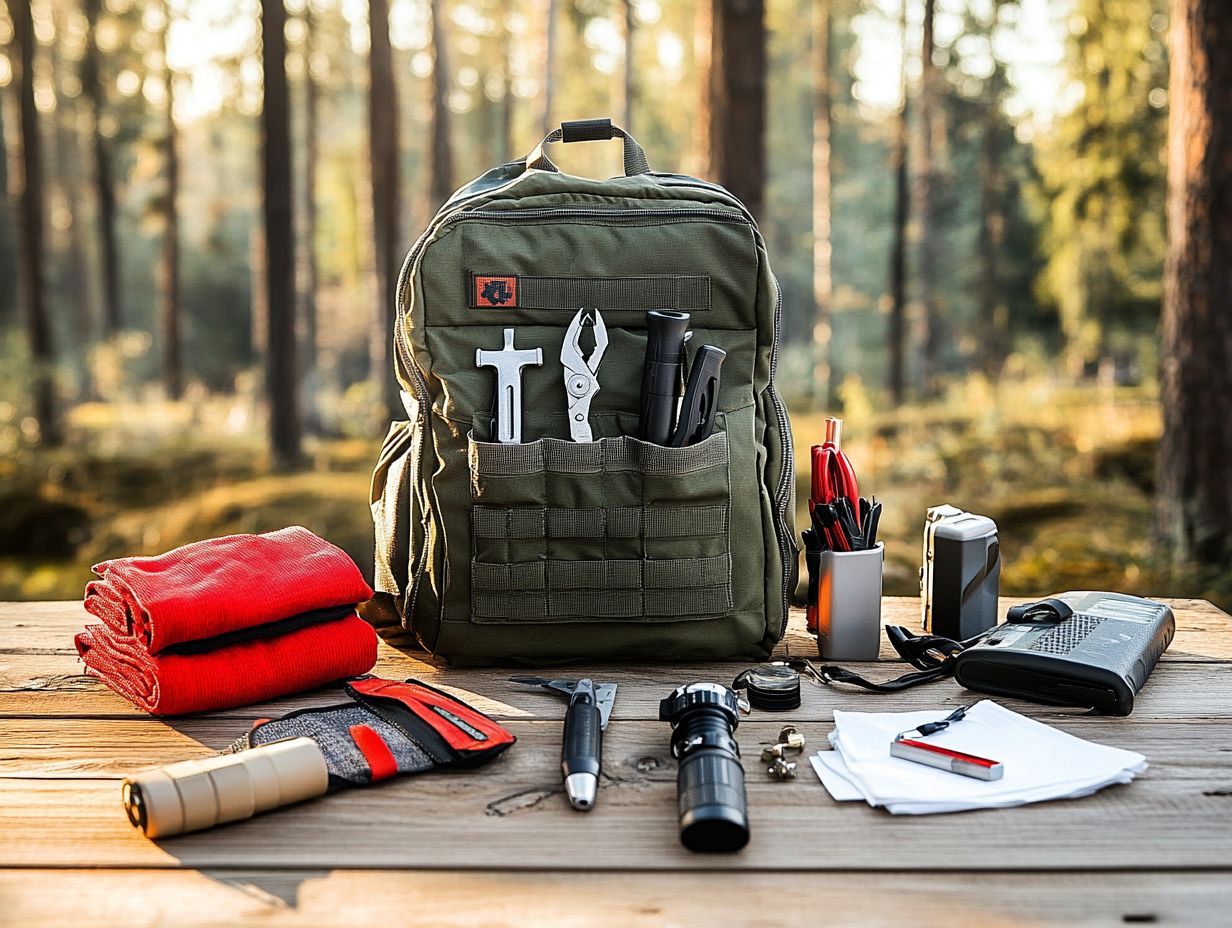
Your first-aid kit is a lifesaver. Make sure it s well-stocked to handle any injuries and medical emergencies that may arise in times of crisis. Include essential first-aid supplies like bandages, antiseptics, and personal hygiene items to manage wounds and maintain your health.
Incorporating safety gear and cleaning agents enhances the kit’s effectiveness, helping to mitigate health risks in emergencies. Proper preparation can significantly improve outcomes when medical assistance isn t readily accessible.
For example, having adhesive bandages in various sizes for cuts and scrapes, along with a reliable antiseptic like Neosporin, can mean the difference between a minor issue and a serious infection. Multi-tools, especially those made by Leatherman, can quickly handle tasks like cutting tape or opening packages, proving invaluable in urgent situations.
Personal hygiene items like hand sanitizers and antibacterial wipes are crucial for reducing the risk of infections when clean water is unavailable. Including disinfectants like hydrogen peroxide ensures proper wound cleaning, a critical step for preventing complications during emergencies.
Effective navigation and communication are crucial for your survival, especially in unfamiliar environments during emergencies. Equip yourself with essential navigation tools, such as maps and compasses, and ensure you have a reliable emergency radio to stay informed and connected to the outside world.
Having an emergency contact list ensures you can reach loved ones or emergency services when it matters most. Tapping into NOAA resources can provide vital updates on weather conditions that may significantly affect your survival efforts.
Incorporating a GPS device can enhance your route-finding accuracy, offering real-time positioning data that can be a lifesaver in dense forests or rough terrains. Stay ahead of the game by checking local conditions regularly using weather apps that pull real-time data from trusted sources.
When compiling your emergency contact list, include the numbers of nearby friends, family, and local emergency services. Keep a hard copy tucked away in your emergency backpack. Regularly review these contacts and stay updated on environmental changes to enhance your awareness in challenging situations. Being prepared gives you peace of mind.
Tools and Equipment
Incorporating the right tools and equipment into your survival gear kit can dramatically enhance your ability to tackle various challenges in emergency situations, particularly during natural disasters. A multi-tool is a game-changer, offering a range of functionalities in one sleek design. An emergency backpack stocked with essential tools ensures effortless transportation.
By using checklists and effective organization tips, you can streamline your preparedness efforts, allowing for quick access to what you need when it matters most.
Consider adding items like a reliable flashlight for visibility, a first aid kit for health issues, and a fire starter to help you create warmth and cook. Water filtration systems are vital for staying hydrated, while maps and compasses will guide you when electronic devices let you down.
When organizing these elements in your emergency backpack, use packing cubes or clear bags to categorize items, labeling each for easy identification. Designate specific sections for larger tools, personal items, and medical supplies to ensure everything is within reach while maximizing space.
A thoughtfully arranged kit not only prepares you for the unexpected but also instills confidence as you navigate the unknown.
Additional Considerations for Your Survival Gear Kit
When assembling your survival gear kit, consider various factors to ensure it s tailored specifically to your needs and the environmental challenges you may face.
Preparation tips will aid you in evaluating your unique situation, including the climate and surroundings you inhabit, which play a significant role in determining the emergency supplies you should include.
By understanding your personal needs and preferences, you can adopt a more effective approach to survival preparedness, ensuring that your kit is not just practical but also perfectly aligned with your lifestyle.
Climate and Environment
The climate and environment shape the emergency supplies in your survival gear kit. Understand your local weather patterns and possible natural disasters like hurricanes or blizzards to make informed choices.
For coastal areas, sturdy, weatherproof gear and strong shelter options are essential. In mountainous regions, prioritize insulated clothing and tools for navigating snow-covered trails.
Don t forget about potential risks like wildfires in dry climates or flooding in areas prone to heavy rainfall.
Creating a comprehensive checklist tailored to these specific risks enhances your preparedness. Include essentials like:
- Portable water purifier
- Non-perishable food
- First aid supplies
Engage with local resources or attend workshops to refine your knowledge. Being well-prepared can make a real difference in emergencies.
Personal Needs and Preferences
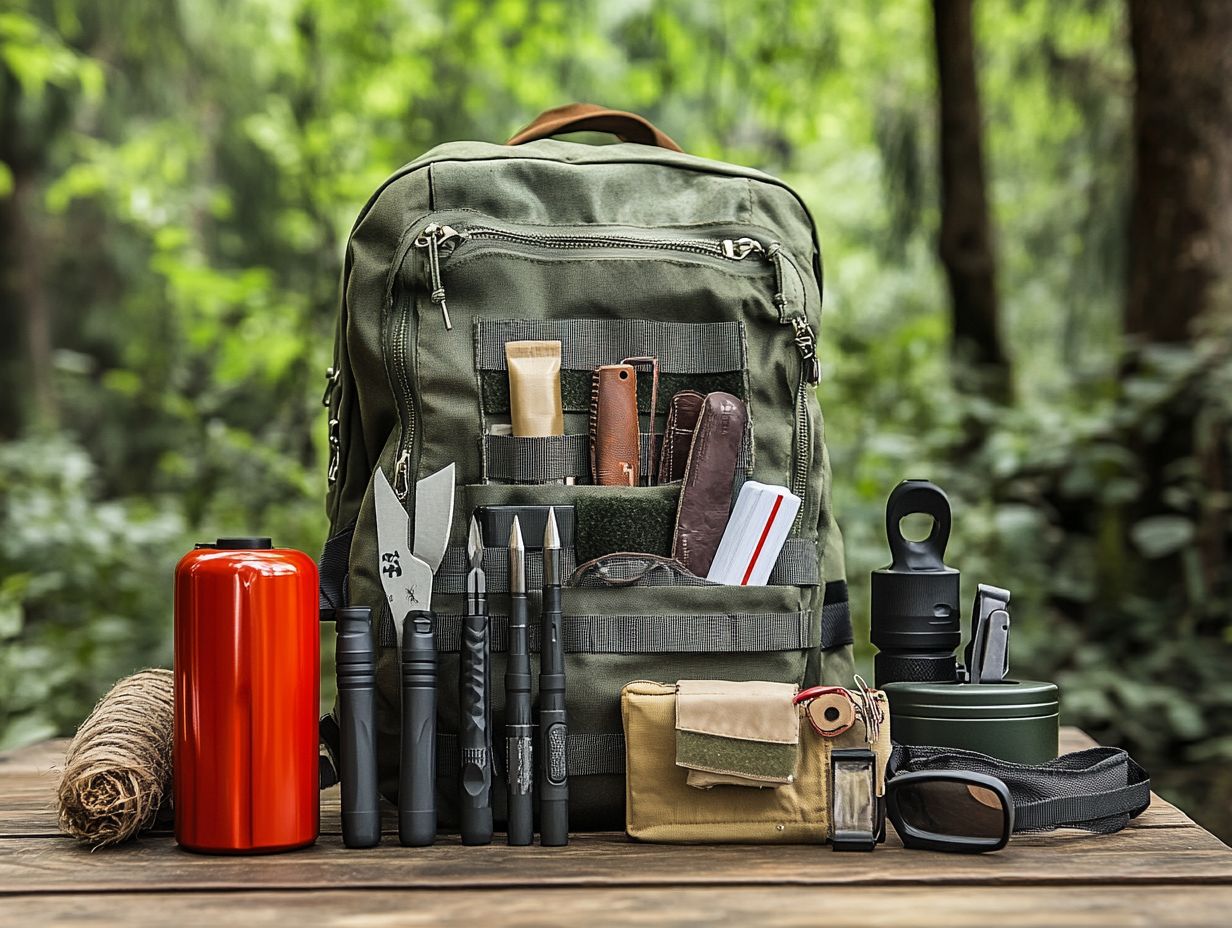
Recognizing your personal needs and preferences is crucial when assembling a survival kit. This ensures the supplies you include are practical for your unique situation.
Think about any food allergies or specific dietary requirements you have. For example, if you re gluten intolerant, choose gluten-free snacks.
If you follow a vegetarian diet, prioritize plant-based protein sources. Consider your physical limitations or mobility issues when selecting supplies.
Ensure any necessary medications are included and stored safely. Pay attention to your lifestyle habits to create a kit that’s effective when it matters most.
Building and Maintaining Your Survival Gear Kit
Building and maintaining your survival gear kit is an ongoing task. It requires careful planning and routine updates to ensure readiness.
A well-organized preparedness checklist serves as your blueprint. Smart organization tips optimize space and accessibility in your emergency backpack.
Regularly revisit the kit to incorporate the latest technologies and supplies. This keeps you well-equipped for unforeseen challenges.
Tips for Building a High-Quality Kit
To create a high-quality survival kit, focus on selecting emergency supplies that fit your needs. Assess potential scenarios, whether they include natural disasters, outdoor adventures, or urban emergencies.
Prioritize versatile items. For example, include a water filtration system that purifies drinking water and aids in cooking. A thermal blanket provides warmth and can serve as a signaling device.
Maintain organization using clear bins or labeled bags. Regularly update your checklist every few months to ensure supplies are well-stocked and functional.
Regular Maintenance and Updates
Regular maintenance and updates are crucial for ensuring that your survival gear kit remains both effective and reliable over time. Establishing a routine schedule to check the contents of your kit allows you to replace expired items, refill supplies, and assess the relevance of each component based on your current needs.
Using a checklist to review your supplies boosts your readiness for emergencies, equipping you for any situation that may arise.
To maximize the effectiveness of this process, consider setting reminders on your calendar every few months. During these checks, take stock of essential items like first-aid supplies, water filtration methods, and food provisions, ensuring everything aligns with your potential survival scenarios whether they involve natural disasters, emergencies, or outdoor expeditions.
Talk to local preparedness groups for fresh insights and reveal new tools or techniques worth integrating into your strategy. By remaining proactive, you not only bolster your readiness but also cultivate confidence in your ability to tackle unforeseen challenges with poise and effectiveness.
Frequently Asked Questions
What to Include in Your Survival Gear Kit?
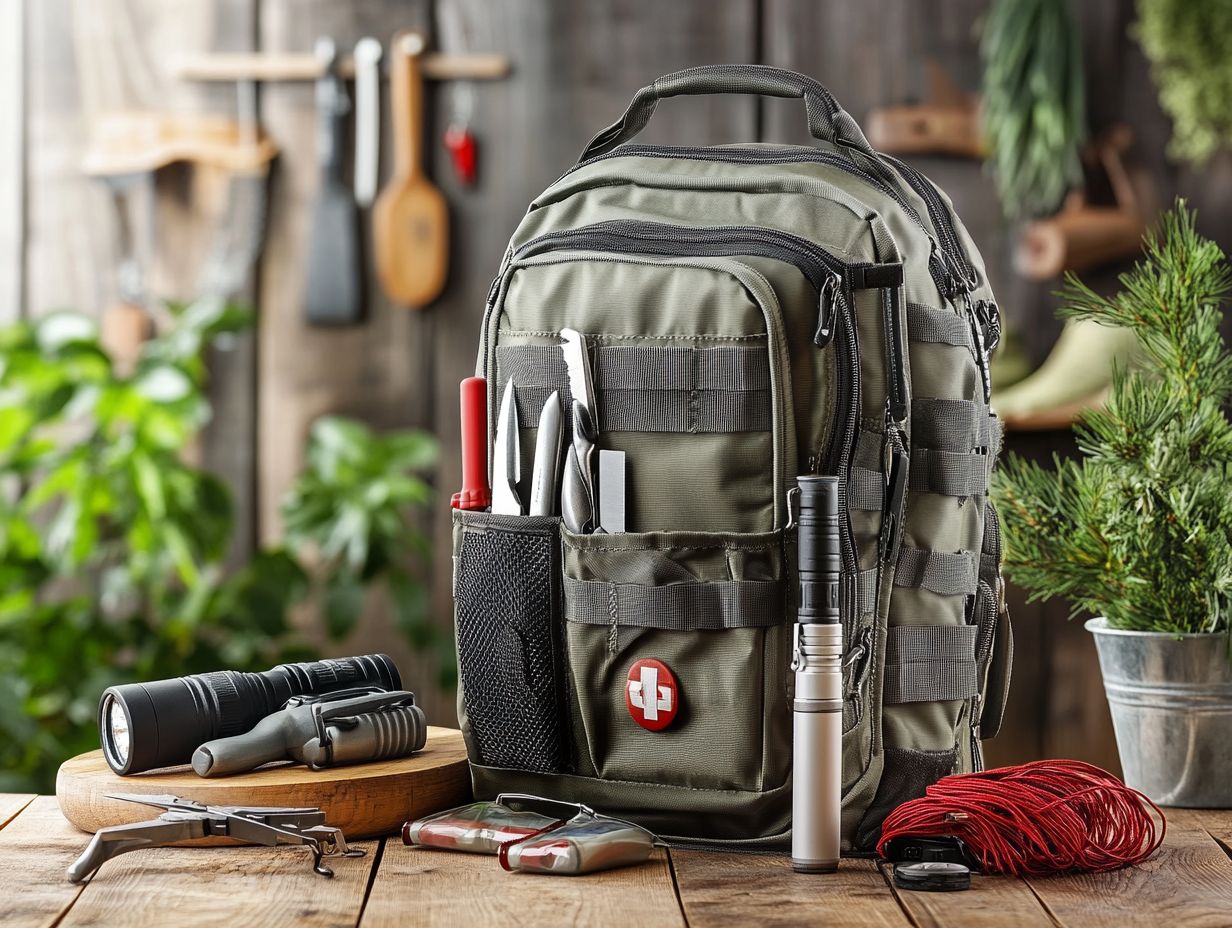
Your survival gear kit should include items that will help you in emergency situations and ensure your safety. These items should be compact, lightweight, and easy to carry.
Why is it Important to Have a Survival Gear Kit?
Having a survival gear kit is crucial because it can save your life in emergency situations. It contains tools and supplies that can help you survive until help arrives.
What are the Essential Items to Include in a Survival Gear Kit?
The essential items to include in a survival gear kit are a first aid kit, water and water purification methods, food, shelter, fire starters, navigation tools (like compasses or GPS units), and self-defense tools.
How Much Water and Food Should be Included in a Survival Gear Kit?
A general rule of thumb is to have at least one gallon of water per person per day. For food, include non-perishable items that can provide enough calories for each person for at least three days.
Do I Need to Customize My Survival Gear Kit?
Yes, it is important to customize your survival gear kit according to your location, climate, and personal needs. For example, if you live in a cold climate, include warm clothing and shelter options in your kit.
How Often Should I Check and Update My Survival Gear Kit?
Check your survival gear kit every six months to ensure you re always prepared! This will ensure that your supplies are not expired or damaged and that you have all the necessary items for different seasons and situations.

